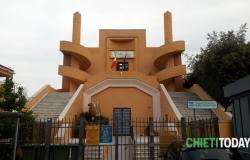The fire in Moria – © Nicolas Economou/Shutterstock
The controversial trial for the disastrous fire that destroyed the Moria refugee camp on the island of Lesbos, which ended with a conviction, saw the defense use new scientific data on the fragility of ecosystems to the threat of fire
“The crime is not the fire, the crime is Moria,” read the banner displayed outside the appeal court on the island of Lesbos on March 6, 2024, as four Afghan asylum seekers awaited a decision on their case.
A few hours later, three of them were released on parole and sent for retrial, as they were minors at the time of the incidents. The trial against the other defendant continued until March 8, 2024, when he was found guilty and sentenced to eight years in prison. The case raised concerns about human rights, the rule of law and security in the migration context.
Chronicle of a tragedy foretold
The four defendants were originally part of the so-called “Moria Six”, a group of six young asylum seekers (five minors and one adult) arrested by the local police a few days after the outbreak of the tragic fire in the Moria refugee camp in September 2020, which it left 13 thousand people without shelter.
At the time of the arrests, firefighters were still investigating. Despite the lack of evidence, images of the “arsonists” in handcuffs immediately made the rounds in the media.
In the meantime, the scandalous living conditions in the camp have come to light. Notis Mitarachi, the then Greek Minister of Migration, tried to appease public opinion with pompous statements: addressing members of the Standing Committee for Public Administration, Public Order and Justice, he stated that the infrastructure in Moria was had already been significantly improved and that those responsible for the fire “would be punished and deported”.
In June 2021, the mixed jury court of Chios found the four defendants guilty of “arson endangering human life” and sentenced them to ten years of imprisonment, based on the written testimony of a single witness.
Although no one could say exactly how it all began, several witnesses linked the tragedy to a series of violent incidents among camp residents in the late hours of September 8, 2020, and in particular, to strong disagreements over isolation measures related to the coronavirus soon turned into an inter-ethnic struggle, which then got out of hand.
Mitarachi stated that “the incidents in Moria started among asylum seekers due to the quarantine.” A few months later, interviewed by a Greek media, he declared that the government’s plan to create a safer refugee camp with decent human conditions in the region had met resistance from local authorities, with disastrous results.
Mitarachi then accused Kostas Moutzouris, the regional governor of the North Aegean, who in turn sued him in April 2021.
The infamous refugee camp has been described by international reporters and aid workers as “hell on earth”, “a ticking time bomb” and “a disaster waiting to happen”, where people were held for years in inhumane conditions.
At its peak, the camp housed more than 14,000 people in a space originally designed for 2,150, and deaths have been reported due to terrible living conditions, poor hygiene and limited food supplies.
A different perspective
The 2021 trial of the four Afghans has been controversial from the start. Since the only witness did not appear in court and was therefore not questioned, the defense pointed to “misinterpretations or incomplete interpretations” of their clients’ intentions and the events of the night of the fire.
In 2023, new evidence came to light: the defense lawyers attempted to reconstruct the facts with the help of research conducted by Forensic Architecture/Forensis on their commission.
The FA/Forensis findings, based on testimonies and official written reports, as well as on the examination of audiovisual material, attributed the fire to geographical, morphological and meteorological conditions which make this Mediterranean region more exposed to fires, especially in September, when “the soil is drier”.
In a press conference held in March 2023, experts Dimitra Andritsou and Stefanos Levidis explained that “drought conditions, combined with precariousness and density resulting from the policies imposed by the Greek and EU authorities, have led to a sharp increase of large fires every year at this time.”
Our analysis,” Andritsou concluded, “reveals significant inconsistencies in the testimony of the key witness and casts further doubt on the evidence on which the young asylum seekers were accused.”
The expert opinion was significantly based on footage shot by the young migrants themselves as part of a training course on filmmaking and reporting offered by an organization working with refugees on Lesvos.
Fire prevention: a question of culture and values
From a broader perspective, this opens a new discussion on the topic of fire prevention and management, especially in high-risk regions such as Lesbos.
Regardless of the final outcome, the fact that a climate/morphology-related hypothesis was used in the experiment highlights the relevance of projects addressing the extreme phenomena affecting Greece.
OBCT interviewed Professor Kostas Kalabokidis, head of the Greek Living Lab (LL) in the FIRE-RES initiative, a project providing innovative solutions for fire-resilient territories in Europe, including Lesvos.
“The forest ecosystems of the Mediterranean region are constantly threatened by extreme fires, which have a significant impact on essential ecosystem services,” says Kalabokidis. “Our studies aim to examine the intricate relationships between fire suppression and management strategies and the different ecosystem services affected by fire, with the aim of developing a comprehensive and tailored framework for fire-resilient landscapes.”
Professor Kalabokidis highlighted how the use of advanced methodological approaches, such as trade-off analysis, scenario planning or stochastic simulations, can help reduce forest fire hazards and risks.
FIRE-RES studies not only environmental factors, but also the socio-economic conditions that can make a region more exposed to fires and other disasters. In the case of the overpopulated Moria camp, population size and density acted as catalysts, combined with the use of cheap, flammable materials.
Other factors include a lack of adequate training among residents and workers on how to prevent and manage a fire-related emergency and limited awareness (especially among young residents, as evidenced by the trial documents) of the consequences of irresponsible behavior that it could lead to a disaster and a serious crime.
FIRE-RES highlights the importance of educating populations living in fire-resistant regions; this could result in a set of attitudes, skills and practices among civilians from different spheres of society, which would allow them to have a better understanding of imminent dangers, but also of viable solutions.
This material is published in the context of the FIRE-RES project co-financed by the European Union. The EU is in no way responsible for the information or points of view expressed in the project; responsibility for the contents lies solely with OBC Transeuropa. Go to the FIRE-RES page
Have you thought about a subscription to OBC Transeuropa? You will support our work and receive preview articles and more content. Subscribe to OBCT!
Comments, where possible, are screened by our staff before being made public. The time required for this operation can vary. Go to our policy
Please enable JavaScript to view the comments powered by Disqus.
blog comments powered by
Tags: Greece fires liability Greece areas Home






